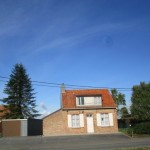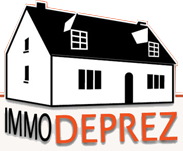- Immo Deprez
- Zwijnlandstraat 6
- 8640 Vleteren
- Tel: 057401645
- GSM: 0495641727
- info@immodeprez.be
- VAT BE 0675 285 096

Low interest rates make it possible to borrow favorably to buy a house. In the short term, this allows a buyer to borrow more. The borrowing capacity, i.e., the amount a buyer can borrow to purchase a home relative to their income, increases. Due to competition among buyers, all buyers can pay more, which drives up prices. Additionally, investors earn less when investing in fixed-income investments such as bonds, savings certificates, etc. As a result, they often choose to invest in real estate to rent out... More demand for real estate means higher prices. The interest rate is determined by the European Central Bank. In June 2024, the European Central Bank lowered the interest rate. The interest rate for a 20-year fixed-rate mortgage is currently around 3% (as of September 19, 2024). This could provide some breathing room for new buyers.
The Spatial Policy Plan for Flanders aims to make the use of new space impossible from 2040 onwards. Even now, building homes, especially with (large) gardens, is heavily restricted by regional plans, the Flemish Spatial Structure Plans, and the construction shift. Obtaining a permit for urban planning actions is increasingly becoming an administrative ordeal, and legal certainty is elusive. A slightly growing population and household downsizing (smaller households) lead to increased demand for housing. Changes of destination are made more difficult or impossible. The restriction of building land supply, combined with higher demand, results in higher land and housing prices. Living space is being limited. According to the governor of the National Bank, Mr. Pierre Wunsch, approximately 70% of the rise in house prices can be explained by the scarcity of building land (interview in De Tijd, February 26, 2022).
The requirements imposed by the Flemish Government during renovations are regularly becoming stricter and more expensive. Requirements are being set for roof and wall insulation, carpentry, heating systems with costly technologies such as cogeneration (a true electricity guzzler!), ventilation, solar boilers, solar panels, and energy studies. These heavy investments are only partially offset by lower energy bills, subsidies (read higher taxes), and lower property taxes. Maintenance costs (pump replacements) and electricity costs for heat pumps and ventilation must also be considered. The renovation obligation, imposed by the Flemish Government, is the culprit here. Personally, I recommend that buyers take a pragmatic approach. Do what is necessary to bring the score in line with current requirements. The 2050 horizon is still far off, and the standards will likely change many times. With targeted interventions (roof insulation, double glazing, installation of some solar panels, a new condensing boiler), the score can usually be lowered enough to meet the current requirements.
When the electricity market was liberalized, we were promised lower electricity prices. According to VREG, the price of electricity for an average household (3500 kWh/year with dual tariffs) increased by 33.51% between January 2015 and October 2020. According to VREG, the cheaper night tariff was abolished on July 1, 2022. The electricity bill consists of 28% network costs, 32% various charges (about thirteen in Flanders), 17% VAT, and 23% electricity (source CREG). Meanwhile, the federal government promises massive investments in gas-fired power plants, wind energy, and solar panels (read higher charges and/or taxes) , the closure of most nuclear power plants and huge investments in power lines. Combine this with the mandatory reduction of CO2 emissions imposed by the European government (with penalties or the purchase of emission rights abroad) and increased electricity consumption for charging electric vehicles, cogeneration, and ventilation. Scarcity, purchasing electricity from abroad (wind energy, nuclear, and lignite), and higher prices seem to be the logical result...
The majority of the water bill consists of fees for water discharge and wastewater treatment, imposed by the Flemish Environmental Agency. Owners of rural homes are required to install a water purification system.
The Flemish Government has an unstoppable tendency to impose more and more requirements and regulations, leading to heavy procedures, additional costs (architects, specialists, the purchase of authentic outdated materials and techniques, sanitation costs, fictitious increases in energy certificates for electric heating or unheated spaces...), and more expensive housing. The many "special areas" or protected properties with additional requirements for construction or renovation bring extra costs. Think of homes recognized as protected heritage, protected monuments, or located in protected landscapes and town or village views, the levies imposed for building in certain areas, the strict regulations on changes in land use, the construction ban in certain areas, the requirements imposed on developers, asbestos regulations, and the mandatory asbestos certificate as of November 23, 2022, waste regulations, the soil remediation decree, the measures imposed by the water test, WORG areas (or was it WURG?)... The list is endless and grows longer each year.
Landlords are forced, through Flemish quality standards for rental properties, to ensure that the rented home offers sufficient comfort and safety. This requires additional investments. An acceptable home with little comfort can no longer be rented out. Tenants, who sometimes cause damage themselves, abuse the inspections by Wonen Vlaanderen to pressure landlords and avoid paying rent. The landlord is forced into continuous new investments, which they, in turn, try to pass on to the tenant. Many landlords, disgusted, throw in the towel, and the rental property is sold or repurposed. For tenants in the lowest income bracket, the right to housing is threatened because they can no longer find affordable housing. Social housing (read subsidized housing) is only available to a limited extent. "Social purchase homes" will come onto the market with prices reaching up to €287,600 in 2025 and in some municipalities (Veurne, De Panne) €316,300 and in other municipalities (Koksijde) up to €345,100 (Source Flemish Housing Fund). Rental subsidies have been introduced but are tied to strict income conditions and the quality standards imposed by Wonen Vlaanderen, which completes the circle. On October 18, 2024, the number of homeless people in the 17 municipalities in the Westhoek region was counted. That day, 688 people in homelessness were counted in the 17 municipalities together, including 495 adults and 193 children.
In recent years, the amount of loan repayment that could be deducted from income for a first home has gradually been reduced. In 2020, this arrangement was abolished for the primary residence in Flanders. Over the loan's term, this can result in a higher tax burden of over €30,000 for a couple with children over 20 years. A 1% reduction in registration fees does not compensate for this. The registration fees for the purchase of a first sole home have been reduced from 6% to 3%. All notarial deeds passed after January 1, 2022, fall under this measure. Fot the deeds passed after the 1st of January 2025 the pourcentage is reduced to 2%.
A special mention goes to the Public Waste Agency of Flanders (OVAM). Soil investigations and remediations have resulted in significant, sometimes astronomical, costs for some owners. The bill was mitigated for some owners through intervention by Promaz. Other properties have become unsellable due to the high costs associated with remediation.
A newcomer is the costs for archaeological research imposed on some construction projects.
In early 2020, the National Bank imposed a requirement on banks for most mortgage loans to have a loan-to-value ratio (i.e., the percentage of the property's value that can be borrowed) of a maximum of 80%. In 2021, a regulation was introduced allowing banks to provide 35% of loans with a loan-to-value ratio higher than 90%. Banks also require additional borrowing for renovation work. As a result, some buyers can no longer take out a mortgage because they lack sufficient personal funds and are forced to rent.
In 2007, the average age at which a couple purchased their first home was 31 years. By the end of 2019, this had risen to 36 years. For singles, it increased from 34 to 37 years (source Immotheker-Finotheker). According to the notary barometer, the average age of a buyer in 2020 was already 42 years.
In Flanders, there were 19,547 homeless people in 2023, according to the Welfare, Health, and Family Support Center.
Immo Deprez
Zwijnlandstraat 6
8640 Vleteren
We do speak English
On parle le français
Hablan Espanol
Deutsch gesprochen
